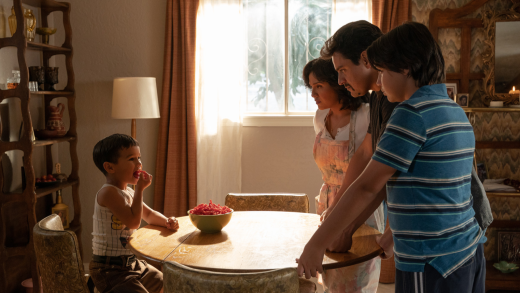Every culture and age has an image of “ideal womanhood,” an idea that, at its most benign, filters down to truisms and expectations on women should behave. As a reader, I’m drawn to characters who are struggling at the edges of what society expects them to do, bursting at the seams to express themselves. Not all rebellions are explosive. Some are quietly performed in the corners of kitchens, some burn deep in a heart unable to express it in the outside world. As a writer, I have always been interested in the idea of agency—especially where agency seems non-existent. How do we, as women, assert ourselves in a deeply patriarchal society? Especially when claiming our voice often invites violence and censure from the society we live in?
When I started writing my novel Small Deaths, I was adamant about one thing: I didn’t want to invent tragedies and plot points where life had been so devastating. There is no incident in the novel that has not happened in reality. Small Deaths is based on years of archival research and talking to the women and intersex persons in Shonagachhi, the largest red=light district in Calcutta, and still writing my main character Lalee was a challenge. In the novel, Lalee is a sex worker who was trafficked as a child, and is now grappling with the reality of ageing, wants to better her circumstances by working as a high-end escort. I wanted to write with empathy, authenticity and ethically, if that makes sense, because how do we talk about sexual violence, assault, and trauma honestly, without turning it into yet another consumable?
This reading list spans various genres and eras, but what they all have in common is a stubborn refusal to flatten the complexities of the women they portrayed, or to look away from the unsavory, often prickly aspects of what makes these women, human.
Kari by Amruta Patil
Kari is a luminous graphic novel about being queer, broke, rudderless, and heartbroken in an Indian metropolis. Wry and cynical, Kari tries to survive in smog city negotiating career challenges, sharing too-tight-for-comfort living space with her roommates, and coping with urban ennui. Gorgeously illustrated, this throbbing book is an example of proto-Sad Girls literature before it became trendy, and a deeply moving meditation on the loneliness of being queer in urban India.
Ghachar Ghochar by Vivek Shanbhag, translated by Srinath Perur
An unnamed narrator sitting in an old-world coffee shop recounts the story of his family and the devastating fault lines without quite revealing them. Nearly destitute, the narrator’s family live together in a warren of rooms till his uncle starts a spice business and their fortunes turn, seemingly overnight. New allegiances are drawn as the balance of power within the household shifts. The narrator’s wife, Anita, is the lone outsider in this familial tribalism, unwilling to subsume her opinions and individualism in the face of mounting pressure.
The Far Field by Madhuri Vijay
After the death of her mother, a restless, sarcastic and combative woman, Shalini is rudderless, drifting from jobs and relationships. Shalini decides to trade her urban Bangalore life to seek out an itinerant Kashmiri salesman with whom her mother had formed a bond. Her search takes her to the politically volatile northern region of Kashmir Valley, where she is taken in by local families. Confronted with the looming threat of violence and the complicated history of the family sheltering her, Shalini is forced to reckon with the dangerous repercussions of being in a situation she neither understands, nor can control, brought on by her privileged naivety.
Em and the Big Hoom by Jerry Pinto
In a small apartment in Bombay, the narrator and his sister live with their parents. Imelda Mendes, Em to her children, is by turns vicious and loving, cruelly forthright and charming. Her bipolar disorder—the suicide attempts and terrifying mood-swings called “microweathers”—is the defining experience of the narrator’s childhood. Their father, the Big Hoom, is the yin to her yang, the stabilizing anchor to the storminess of their lives. Em and the Big Hoom is a raw and nuanced portrait of a woman in the trenches of mental illness, and an exquisite sketch of Goan Christian life in Bombay.

Desperately Seeking Shah Rukh: India’s Lonely Young Women and the Search for Intimacy and Independence by Shrayana Bhattacharya
Wearing her economist hat well but lightly, Bhattacharya maps the lives and desires of ten women over the years. These women are vastly different in economic and social class, ranging from poor small-town girls to wealthy Delhi women, from battered wives to domestic workers. This nonfictional work is illuminating in its astute observations on women’s search for intimacy and autonomy in the post ’90s economic liberalization society in India. Blending data, statistics, and interviews with analysis of the Bollywood superstar Shahrukh Khan’s movies, Bhattacharya creates a unique portrait of contemporary Indian womanhood and female fandom.
Burnt Sugar by Avni Doshi
“I would be lying if I said my mother’s misery has never given me pleasure.”
By now, the opening sentence of Doshi’s searing mother-daughter saga has been widely lauded for its chilling accuracy. Burnt Sugar is the story of Tara, a chaotic woman who eschewed the trappings of domesticity to chase after a religious guru. She lived both as an artist and as a beggar to spite her wealthy parents—all with a child in tow, her daughter Antara. Created in Tara’s shadow and to serve as her “other,” Antara is our deeply caustic narrator. As a child she was constantly rebuffed, spurned, and thrown in harm’s way by her mother, but as Tara starts losing her mind to Alzheimer’s, Antara finds herself thrusted into the role of reluctant caregiver. The novel is a delicate dance of love and betrayal, slowly revealing the deep cuts that mother and daughter inflict on each other.
It Does Not Die by Maitreyi Devi
Set in colonial Calcutta in 1930, Maitreyi Devi is a precocious and educated 16-year-old, a poet who participates in a public intellectual life quite unheard of in a deeply patriarchal society. Her philosopher father—an adopter of 19th-century enlightenment ideals—invites a Romanian scholar, Mircea Eliade, into his home to study with his daughter under his tutelage. Thus begins a smoldering love story that crosses cultural and racial boundaries.
40 years later, Devi reads Bengal Nights, Eliade’s fictionalized account of their desperate, furious, but short-lived teenage love. Unsettled by the fantasy Eliade creates in his book, Devi sets out to reclaim her narrative of their relationship, culminating in a journey to meet the now old and blind Eliade. At once a portrait of a high-caste Hindu household in a time of late colonialism and a searing unfolding of a secret first love, It Does Not Die is an unmissable gem.
The post 7 Books About Indian Women Who Defy Cultural Expectations appeared first on Electric Literature.
Source : 7 Books About Indian Women Who Defy Cultural Expectations









